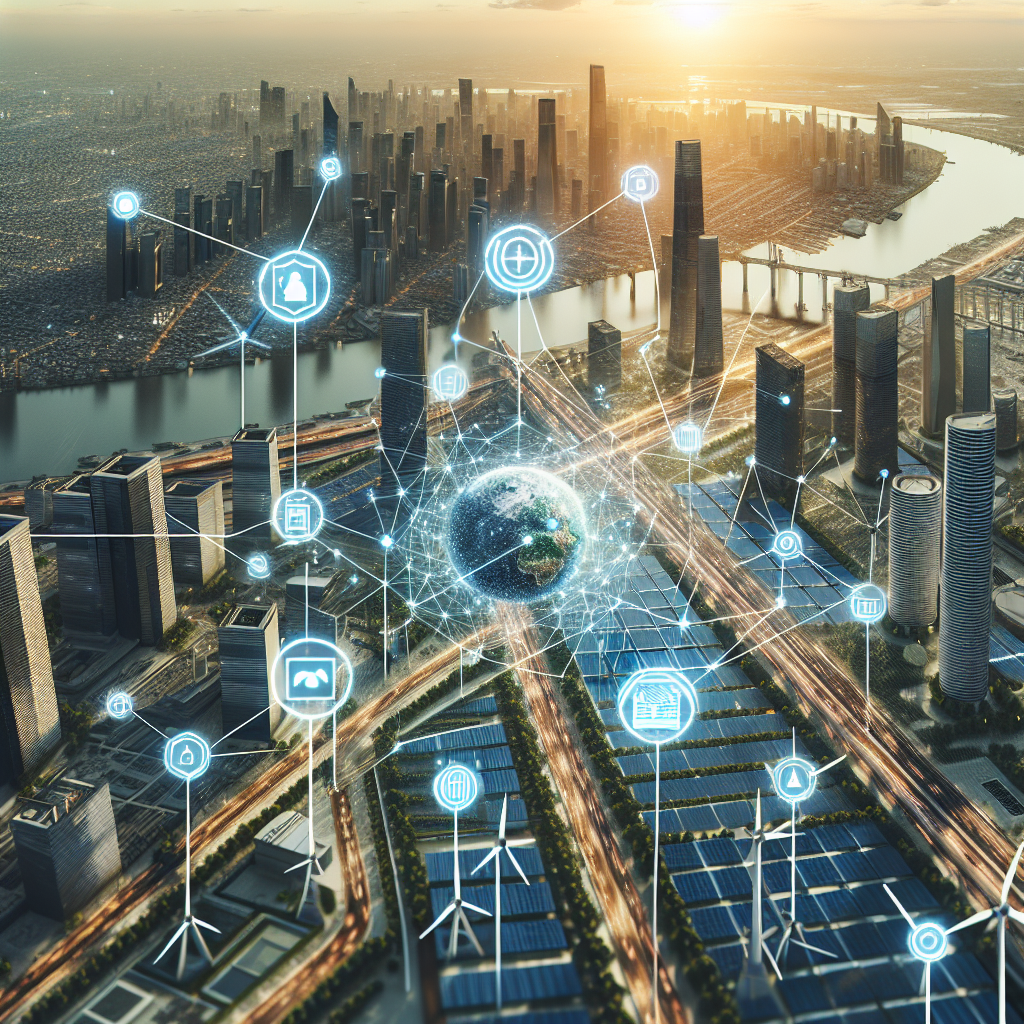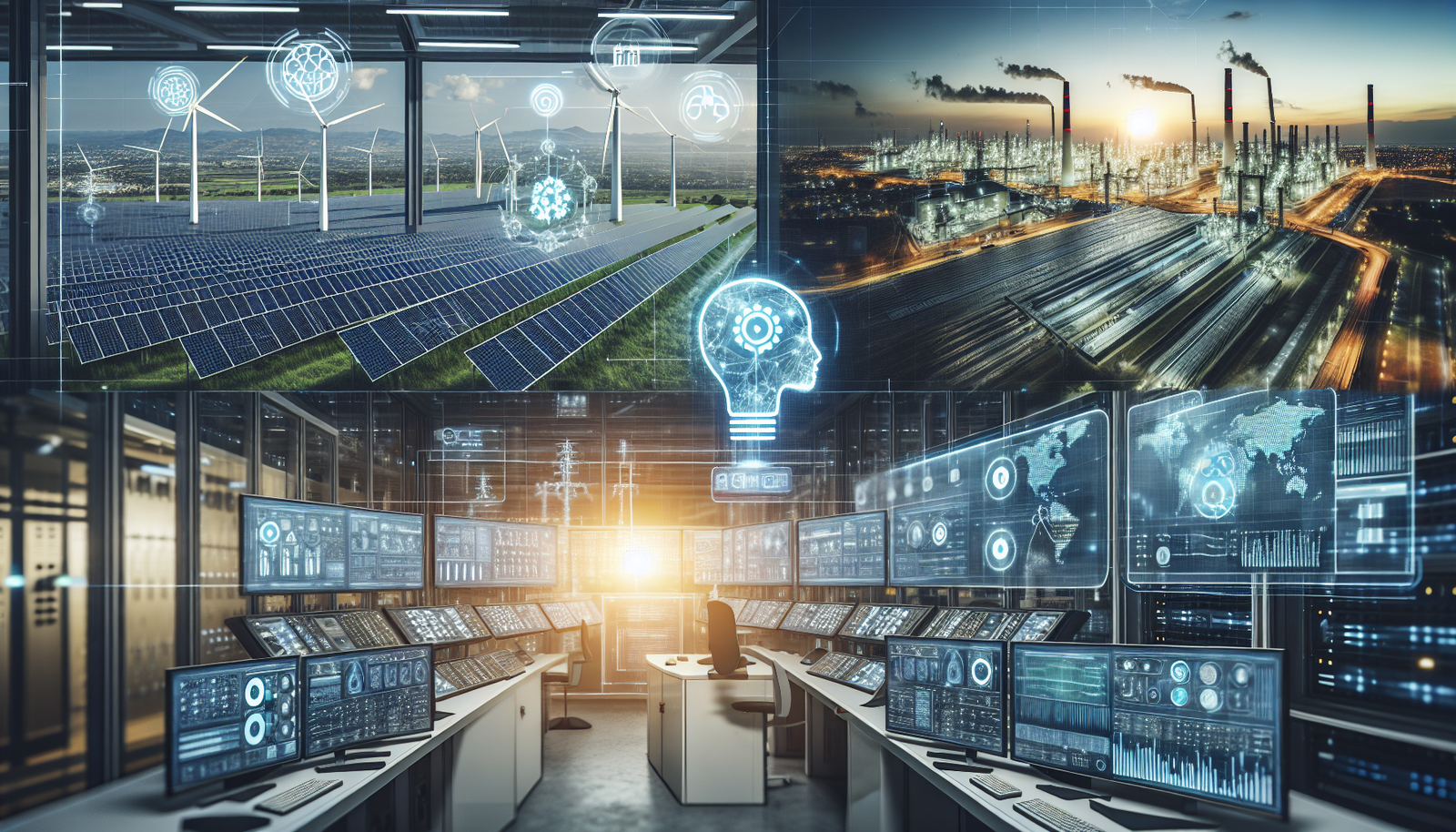AI in Climate Modeling
Artificial Intelligence (AI) is playing a transformative role in climate modeling, offering unprecedented accuracy and efficiency. Traditional climate models rely heavily on physical principles and require substantial computational resources. However, AI-enhanced models can optimize these processes by identifying patterns and making predictions based on large datasets. This not only speeds up the modeling process but also enhances the precision of predictions concerning temperature changes, precipitation patterns, and extreme weather events.
One of the significant advantages of using AI in climate modeling is its ability to process vast amounts of climate data quickly and accurately. AI algorithms, such as neural networks and machine learning, can analyze historical climate data to predict future climate scenarios. This capability allows researchers to have a more comprehensive understanding of potential climate shifts and their impacts. For instance, by employing AI, scientists can better predict the frequency and intensity of hurricanes, helping communities to prepare and adapt more effectively.
Moreover, AI can assist in identifying regional climate variations with more granularity. Traditional models often struggle with regional discrepancies, but AI can bridge this gap by incorporating localized data. This is particularly useful for developing countries where climate data may be sparse. By leveraging AI, these regions can develop tailored adaptation strategies, enhancing their resilience to climate change.
The integration of AI in climate modeling is not without challenges. Ensuring data accuracy and model transparency is crucial. However, the potential benefits, such as improved prediction accuracy and the ability to model complex systems, make AI an indispensable tool in the fight against climate change. As AI technology continues to advance, its role in climate modeling is expected to grow, providing critical insights that will drive sustainable environmental policies.
Renewable Energy Optimization
Artificial Intelligence (AI) is transforming the renewable energy sector by enhancing the efficiency and effectiveness of energy generation, storage, and consumption. Through sophisticated algorithms, AI systems can predict energy demand and supply patterns, optimizing the use of renewable resources such as solar, wind, and hydroelectric power. By analyzing vast amounts of data in real-time, AI enables energy providers to adjust output dynamically, ensuring that energy production aligns closely with consumption needs.
One of the critical areas where AI is making a substantial impact is in the optimization of solar and wind farms. AI-driven predictive analytics can forecast weather conditions and adjust the positioning of solar panels and wind turbines to maximize energy capture. For instance, AI algorithms can predict cloud cover or wind speed changes, optimizing the angles of solar panels or the orientation of turbines accordingly.
Moreover, AI contributes to the improvement of energy storage systems, which are crucial for balancing supply and demand. AI can enhance battery management systems by predicting usage patterns and optimizing charging and discharging cycles. This not only extends the lifespan of batteries but also ensures that stored energy is available when it is most needed. Below is an example of how AI impacts different aspects of renewable energy:
| Aspect | AI Impact |
|---|---|
| Solar Energy | Predicts cloud cover to adjust panel angles for maximum efficiency |
| Wind Energy | Forecasts wind patterns to optimize turbine orientation |
| Energy Storage | Enhances battery life and management through predictive analytics |
In conclusion, the integration of AI in renewable energy systems is not just enhancing current capabilities but is also paving the way for future innovations. As AI technology continues to evolve, its ability to analyze and respond to complex data sets will further enhance the efficiency, reliability, and sustainability of renewable energy sources, contributing significantly to global efforts to combat climate change.
Smart Grids and Energy Management
Smart grids are revolutionizing the way we manage and distribute energy, playing a pivotal role in reducing carbon emissions and enhancing efficiency. These advanced systems utilize artificial intelligence to optimize energy distribution, predict demand, and integrate renewable energy sources seamlessly. By analyzing data in real-time, AI can help utilities identify inefficiencies and potential failures in the grid, ensuring a more reliable and sustainable energy supply.
One of the key features of smart grids is their ability to incorporate renewable energy sources such as solar and wind power. Through AI-driven predictive analytics, these grids can forecast energy production based on weather patterns and adjust energy distribution accordingly. This not only maximizes the use of renewable resources but also minimizes reliance on fossil fuels. Below is a simple representation of energy sources in a smart grid:
| Energy Source | Percentage |
|---|---|
| Solar | 25% |
| Wind | 30% |
| Hydro | 15% |
| Fossil Fuels | 30% |
Furthermore, AI enhances energy management through the development of smart meters and home energy management systems. These technologies allow consumers to monitor their energy usage in real-time and adjust their consumption habits accordingly. AI algorithms can suggest optimal energy usage times, reducing peak demand and lowering electricity bills for consumers. An overview of the benefits of smart energy management includes:
- Reduced energy wastage
- Lower electricity costs
- Increased use of renewable resources
- Enhanced grid reliability
In conclusion, the integration of AI in smart grids and energy management systems offers a promising pathway to achieving a more sustainable and efficient energy future. By harnessing the power of AI, we can significantly reduce our carbon footprint and make strides towards combating climate change.
Precision Agriculture and Resource Efficiency
Precision agriculture is a transformative approach that leverages AI to enhance agricultural productivity while minimizing environmental impact. By utilizing advanced data analytics and machine learning algorithms, farmers can optimize the use of resources such as water, fertilizers, and pesticides. This not only increases crop yields but also reduces the ecological footprint of farming practices. AI-driven systems can analyze large datasets from various sources, including satellite imagery, weather forecasts, and soil sensors, to provide actionable insights for farmers.
One of the key benefits of AI in precision agriculture is its ability to predict crop health and yield outcomes. By creating sophisticated models, AI can forecast potential issues and suggest interventions before they become critical, ensuring efficient resource use. Moreover, AI technologies can facilitate the precise application of inputs, such as irrigation and fertilizers, by determining the exact amount needed for different sections of a field. This targeted approach not only enhances the growth of crops but also conserves resources, promoting sustainability.
Another significant aspect is resource efficiency, which is crucial in the context of climate change. AI can optimize the entire supply chain, from planting to harvesting and distribution, reducing waste and improving energy efficiency. For instance, AI algorithms can schedule irrigation based on real-time weather data, preventing water wastage. Similarly, AI can assist in designing efficient crop rotation plans that maintain soil health and enhance carbon sequestration.
To illustrate the impact of AI on resource efficiency, consider the following data:
| Resource | Traditional Methods | AI-Enabled Methods |
|---|---|---|
| Water Usage | High | Reduced by up to 30% |
| Fertilizer Use | Variable | Optimized, reducing excess by 20% |
| Pesticide Application | Frequent | Targeted, decreasing use by 25% |
These improvements in resource efficiency can significantly contribute to the reduction of greenhouse gas emissions, illustrating how AI is instrumental in fostering a sustainable agricultural future. By refining these practices, AI not only aids in climate change mitigation but also supports the global goal of achieving food security in an environmentally sustainable manner.
Wildlife Conservation and Monitoring
Artificial Intelligence (AI) is playing a pivotal role in wildlife conservation and monitoring, offering innovative solutions to track and protect endangered species. By utilizing AI-powered tools, conservationists can analyze vast amounts of data from camera traps, drones, and satellite imagery to monitor animal populations and behaviors more efficiently than ever before. This technology allows for real-time surveillance and analysis, providing crucial insights into habitat use, migration patterns, and potential threats.
The integration of AI in wildlife monitoring has led to significant advancements in the accuracy and speed of data collection. For instance, machine learning algorithms can be trained to identify specific species from images and videos, drastically reducing the time required for manual identification. This not only accelerates the research process but also enhances the precision of population estimates and biodiversity assessments. Moreover, AI systems can predict poaching activities by analyzing patterns and identifying hotspots, enabling proactive measures to protect vulnerable species.
Several projects around the world are harnessing AI to bolster conservation efforts. A few notable initiatives include:
- Using AI-driven drones to survey large and remote areas, capturing detailed images and videos for analysis.
- Implementing AI models to forecast the impact of climate change on habitats and guide conservation strategies.
- Deploying acoustic sensors with AI algorithms to monitor and analyze animal sounds, helping identify species presence and abundance.
AI’s contribution to wildlife conservation is further illustrated in the table below, highlighting key benefits and applications:
| AI Application | Benefit | Example |
|---|---|---|
| Image Recognition | Faster species identification | Camera trap analysis |
| Predictive Analytics | Forecasting poaching threats | Anti-poaching patrol planning |
| Drone Surveillance | Coverage of remote areas | Habitat monitoring |
| Acoustic Monitoring | Species detection via sound | Bird population studies |
Carbon Footprint Reduction
Artificial Intelligence (AI) is playing a pivotal role in reducing carbon footprints across various industries. By leveraging advanced analytics and machine learning algorithms, AI can identify inefficiencies and suggest optimizations that lead to significant reductions in carbon emissions. For instance, AI systems can analyze energy consumption patterns in manufacturing processes and recommend adjustments that enhance energy efficiency, thereby lowering the carbon output. Moreover, AI-driven automation in logistics can optimize routes for transportation, cutting down fuel consumption and minimizing emissions.
One of the key areas where AI is making an impact is in energy management. AI-powered smart grids are revolutionizing how electricity is distributed and consumed. These smart grids use AI algorithms to predict energy demand accurately and manage supply accordingly, reducing waste. Furthermore, AI can integrate renewable energy sources more effectively into the grid by predicting weather patterns and adjusting the energy mix in real-time to ensure efficient usage of resources. This not only helps in reducing the reliance on fossil fuels but also decreases the overall carbon footprint of energy production.
AI technologies are also instrumental in enhancing sustainable urban planning. By analyzing data from various sources, including satellite imagery and IoT sensors, AI can provide insights into urban heat islands, traffic congestion, and waste management systems. This data-driven approach enables city planners to make informed decisions that lead to the development of greener cities. For example, AI can suggest optimal locations for green spaces or renewable energy installations, contributing to a decrease in urban carbon emissions.
In addition to these applications, AI’s role in carbon footprint reduction extends to agriculture through precision farming techniques. AI systems can predict crop yields, monitor soil health, and manage water resources efficiently. By optimizing these agricultural processes, AI not only enhances productivity but also reduces the carbon emissions associated with traditional farming methods. This holistic approach to carbon footprint reduction demonstrates the transformative potential of AI in paving the way for a sustainable future.
Urban Planning and Smart Cities
Urban planning plays a critical role in addressing climate change, and AI is at the forefront of transforming cities into sustainable ecosystems. By leveraging AI technologies, urban planners can optimize resource allocation, reduce emissions, and enhance the quality of life for city dwellers. AI-driven models can analyze vast amounts of data to predict urban growth patterns, helping to design cities that are both efficient and environmentally friendly.
One of the key areas where AI contributes significantly is in the development of smart cities. These cities utilize AI to integrate various systems, such as energy, transportation, and waste management, to operate more cohesively. For instance, AI can optimize traffic flow, reducing congestion and emissions through intelligent traffic management systems. Furthermore, AI can facilitate the integration of renewable energy sources into the urban grid, ensuring a more sustainable energy supply.
Data visualization plays an essential role in urban planning by providing clear insights into complex data sets. Below is a table illustrating how AI technologies are applied in different urban management sectors:
| Sector | AI Application | Impact |
|---|---|---|
| Transportation | Traffic prediction and optimization | Reduces congestion and emissions |
| Energy | Smart grid management | Increases efficiency and incorporates renewables |
| Waste Management | Automated sorting systems | Improves recycling rates and reduces landfill use |
In conclusion, the integration of AI in urban planning and the development of smart cities hold immense potential for combating climate change. By harnessing the power of AI, cities can become more resilient and sustainable, paving the way for a greener future.
Transportation and Emission Reduction
The transportation sector remains one of the largest contributors to global greenhouse gas emissions. Artificial Intelligence (AI) has the potential to significantly reduce these emissions by optimizing various aspects of transportation systems. Through the use of advanced algorithms, AI can improve traffic flow, enhance public transportation efficiency, and support the development of autonomous electric vehicles, all of which can lead to substantial reductions in carbon emissions.
One of the primary ways AI contributes to emission reduction is by optimizing traffic management systems. By analyzing real-time data from sensors and cameras, AI can predict traffic patterns and adjust signals to minimize congestion. This not only reduces idling times for vehicles but also decreases fuel consumption and emissions.
- In cities like Los Angeles, AI-driven traffic management systems have reduced travel time by up to 20%.
- Similarly, Singapore’s smart traffic solutions have cut down vehicular emissions significantly.
Moreover, AI is playing a critical role in the transition to electric and autonomous vehicles. These technologies rely on AI for efficient route planning and energy management, ensuring that vehicles use the least amount of energy possible. In addition, AI helps in the design of more efficient battery systems and the integration of renewable energy sources for charging stations.
- AI-driven route optimization can reduce energy consumption by up to 30% in electric vehicles.
- Autonomous vehicles, when fully integrated, are expected to decrease transportation emissions by 50% by 2030.
Furthermore, AI aids in the enhancement of public transportation systems by predicting demand and optimizing routes. This ensures that public transport operates at maximum efficiency, encouraging more people to choose buses and trains over personal vehicles, thereby reducing the overall carbon footprint. According to a study in New York City, implementing AI in public transport scheduling increased passenger numbers by 15% while cutting down emissions by 20%.
| City | Emission Reduction | AI Application |
|---|---|---|
| Los Angeles | 20% | Traffic Management |
| Singapore | Significant | Smart Traffic Solutions |
| New York City | 20% | Public Transport Scheduling |
Waste Management and Recycling
Artificial Intelligence is transforming waste management and recycling processes by introducing efficiency and precision in sorting, processing, and reducing waste. Traditional waste management systems face challenges such as contamination of recyclables and inefficient sorting, which AI can adeptly address. By employing advanced image recognition and machine learning algorithms, AI systems can accurately identify and separate different types of waste, significantly reducing contamination rates and improving recycling quality.
One practical application of AI in this field is the use of smart sorting robots equipped with sensors and cameras. These robots can differentiate between various materials, such as plastics, metals, and paper, allowing for more precise sorting. This not only enhances the recycling process but also increases the purity of recycled materials, making them more valuable and easier to reuse. Additionally, AI can optimize collection routes and schedules, reducing fuel consumption and emissions associated with waste transport.
| Material | Traditional Sorting Efficiency (%) | AI-Assisted Sorting Efficiency (%) |
|---|---|---|
| Plastics | 60 | 90 |
| Metals | 70 | 95 |
| Paper | 65 | 92 |
The implementation of AI-driven analytics further contributes to waste reduction by analyzing consumption patterns and waste generation trends. This data can help industries and municipalities to devise more effective waste management strategies and policies. Moreover, AI-powered systems can provide insights into consumer behavior, encouraging responsible consumption and waste disposal practices. By promoting a circular economy, AI not only aids in reducing the volume of waste sent to landfills but also conserves natural resources and reduces the carbon footprint associated with material production and disposal.
Disaster Prediction and Response
Artificial Intelligence (AI) is playing a crucial role in enhancing our ability to predict and respond to natural disasters, which are becoming increasingly frequent and severe due to climate change. By analyzing vast amounts of data from various sources such as weather patterns, historical disaster records, and satellite imagery, AI systems can provide early warnings and improve the accuracy of disaster predictions. This capability is vital for minimizing the impact of disasters on communities and ecosystems.
One of the significant contributions of AI in disaster management is its ability to predict the likelihood and potential impact of events such as hurricanes, floods, and wildfires. For instance, AI models can analyze data from past hurricane seasons to forecast future occurrences with greater precision. Governments and emergency response teams can use these predictions to plan and allocate resources more effectively, potentially saving lives and reducing economic losses. Moreover, AI-driven platforms can optimize evacuation routes, ensuring that affected populations receive timely guidance on how to reach safety.
In response to disasters, AI technologies are also being utilized to coordinate relief efforts. Through the use of real-time data analysis, AI can assist in identifying the most affected areas and prioritize the distribution of resources such as food, water, and medical supplies. Additionally, AI-powered drones and robots can be deployed to assess damage and deliver aid in areas that are difficult to reach by conventional means. As a result, AI is helping to streamline disaster response operations, making them more efficient and effective.
The integration of AI in disaster prediction and response is supported by various data visualizations that enhance understanding and decision-making. For example, heat maps can display areas with the highest risk of flooding, while bar graphs can illustrate the frequency and severity of wildfires over recent years. These visual tools allow policymakers and emergency responders to quickly grasp complex data sets and make informed decisions that can mitigate the adverse effects of climate change-induced disasters.
Public Awareness and Education
Artificial Intelligence (AI) is not only instrumental in directly addressing the technical challenges of climate change but also plays a crucial role in enhancing public awareness and education on this pressing issue. By leveraging AI-driven platforms, educators and communicators can disseminate information more effectively, tailoring content to diverse audiences. AI algorithms analyze user behavior and preferences, enabling the creation of personalized educational experiences that engage individuals more deeply with climate change topics.
One significant advantage of AI in public education is its ability to break down complex climate data into understandable formats. For instance, AI can generate interactive visualizations that illustrate the impact of global warming over time or the benefits of adopting renewable energy sources. These tools can be integrated into school curriculums, community workshops, and online courses, making climate education more accessible and engaging for learners of all ages.
Furthermore, AI-powered chatbots and virtual assistants are increasingly being used to answer questions and provide real-time information on climate change. These tools can operate around the clock, offering instant support and resources to individuals seeking to learn more about sustainable practices. By making climate education more interactive and responsive, AI helps foster a more informed public that is better equipped to participate in climate action.
To illustrate the potential of AI in education, consider the following table that outlines various AI applications in enhancing public awareness:
| AI Application | Function | Impact |
|---|---|---|
| Interactive Visualizations | Converts complex data into easy-to-understand graphics | Increases comprehension and retention of climate information |
| Personalized Learning Platforms | Adapts educational content to user preferences | Enhances engagement and motivation to learn about climate change |
| AI Chatbots | Provides real-time information and answers queries | Improves accessibility to climate education resources |
Policy Making and Implementation
Artificial Intelligence (AI) plays a pivotal role in shaping and implementing effective climate policies. By leveraging vast datasets, AI can provide policymakers with actionable insights that drive informed decision-making. Advanced algorithms analyze climate data to predict future conditions, assess the impact of proposed policies, and identify the most effective strategies for reducing greenhouse gas emissions. AI’s ability to process and interpret complex environmental data allows for the creation of more targeted and efficient policies that address specific regional and global climate challenges.
One of the key areas where AI contributes to policy making is through predictive modeling. These models can simulate the effects of various policy scenarios, helping policymakers understand potential outcomes and adjust their strategies accordingly. For example, AI can model the long-term impacts of carbon pricing or subsidies for renewable energy projects. Such insights are invaluable for crafting policies that not only aim to mitigate climate change but also support economic growth and social equity.
In the realm of policy implementation, AI enhances the monitoring and enforcement of climate policies. By utilizing remote sensing technologies and AI-driven analytics, governments can track compliance with environmental regulations in real-time. This capability is especially beneficial for monitoring deforestation, illegal mining, and emissions from industrial activities. AI systems can alert authorities to violations, ensuring timely intervention and maintaining the integrity of climate commitments.
AI also facilitates international collaboration in climate policy. By providing a common platform for data sharing and analysis, AI fosters cooperation among nations to address global climate issues. This collaborative approach is evident in initiatives like the Global AI Action Alliance, which aims to harness AI’s potential for sustainable development and climate action. Through AI, countries can align their policies and actions, creating a unified front against climate change.
Challenges and Ethical Considerations
The integration of AI in combating climate change is not without its challenges and ethical considerations. One major challenge is the energy consumption associated with AI technologies themselves. Training large AI models requires significant computational power, which in turn demands substantial energy resources. This paradoxically contributes to carbon emissions, counteracting the very purpose of using AI for climate change mitigation. It is crucial for researchers and developers to focus on optimizing AI algorithms to be more energy-efficient and to seek renewable energy sources to power AI infrastructures.
Moreover, there are ethical considerations that come with deploying AI solutions at scale. Data privacy and security are paramount, as AI systems often rely on vast amounts of data to function effectively. Ensuring that data is collected and used in a manner that respects individual privacy rights is essential. Additionally, there is the risk of biased algorithms, which can lead to unequal impacts across different communities. Developers must therefore ensure that AI systems are trained on diverse datasets and regularly audited to mitigate any potential biases.
Another ethical concern is the potential displacement of jobs as AI automates certain processes within sectors like energy and transportation. While AI can enhance efficiency and reduce emissions, it also poses a risk to employment, particularly for workers in industries that are heavily reliant on fossil fuels. It is important to balance technological advancement with social responsibility, providing retraining and support for affected workers to transition into new roles within the green economy.
There is also the issue of global inequality. AI technologies are often concentrated in developed countries, potentially widening the gap between nations in terms of capabilities to combat climate change. Developing countries may lack the resources and infrastructure to implement AI solutions effectively, which could exacerbate existing inequalities. An equitable distribution of AI advancements and international collaboration is necessary to ensure that all nations can benefit from AI-driven climate solutions, fostering a truly sustainable future for the planet.



